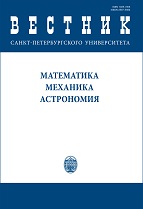|
This article is cited in 2 scientific papers (total in 2 papers)
ASTRONOMY
Numerical modeling of collisions of spheroidal galaxies: mass loss efficiency by baryon components
A. V. Titov, A. V. Khoperskov
Volgograd State University, 100, pr. Universitetsky, Volgograd, 400062, Russian Federation
Abstract:
The dynamics of the collision of two spheroidal galaxies, each of which consists of stellar and gas components inside a live massive dark halo, is considered in detail based on numerical simulations. Dark matter and stars are collisionless components, so their dynamics is modeled by the system of N body particles, and the gas component is described by the equations of gas dynamics. The calculation of gravitational forces is based on the direct summation method of the gravitational contribution from each particle, which provides the highest possible accuracy. We vary the impact parameter, the initial collision velocity, the masses of the three components for each model of galaxies in order to estimate the relative fractions of the masses that are lost by both galaxies as a result of close interactions, as well as the masses of gas and stars that are exchanged between the two galaxies during the scattering process. Estimating this exchanged mass of gas requires a Lagrangian approach to simulate gas dynamics, and the Smoothed Particle Hydrodynamics method tracks the trajectory of each smoothed particle. There are two regions of parameters that separate the merging of two objects into one (large merging) and the case of scattering, when both gravitating systems move away from each other after interaction. Collisionless components (dark matter + stars) in the interaction of approximately the same galaxies lose their maximum mass at parameters close to the boundary between merging and scattering. If the initial masses of colliding galaxies differ greatly then the lost fraction of mass is large for a low-mass object and small for a massive galaxy. The formation of global shock waves in colliding systems is a key factor determining the efficiency of sweeping gas out of the gravitational potential well. The efficiency of the stellar component transition from one object to another is negligible. Gas exchange can exceed 10 percent of the mass for a certain range of values of the impact parameter and the initial collision velocity.
Keywords:
numerical simulations, N body model, computational fluid dynamics, SPH method, collision of galaxies.
Received: 03.08.2021
Revised: 31.08.2021
Accepted: 02.09.2021
Citation:
A. V. Titov, A. V. Khoperskov, “Numerical modeling of collisions of spheroidal galaxies: mass loss efficiency by baryon components”, Vestnik of Saint Petersburg University. Mathematics. Mechanics. Astronomy, 9:1 (2022), 176–189; Vestn. St. Petersbg. Univ., Math., 9:1 (2022), 124–134
Linking options:
https://www.mathnet.ru/eng/vspua52 https://www.mathnet.ru/eng/vspua/v9/i1/p176
|

|




 Contact us:
Contact us: Terms of Use
Terms of Use
 Registration to the website
Registration to the website Logotypes
Logotypes







 Citation in format
Citation in format 
